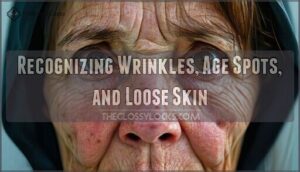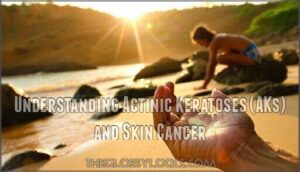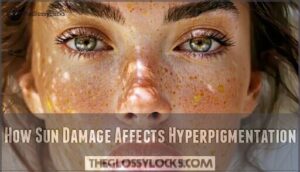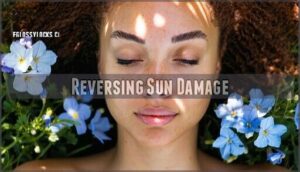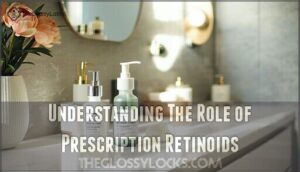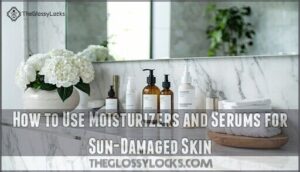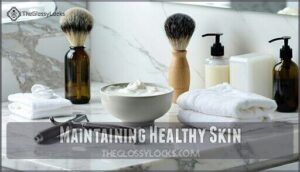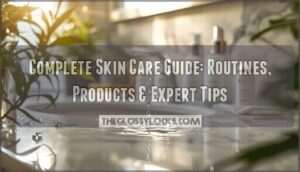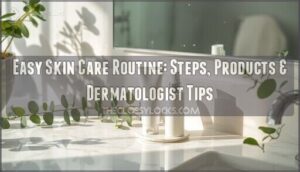This site is supported by our readers. We may earn a commission, at no cost to you, if you purchase through links.
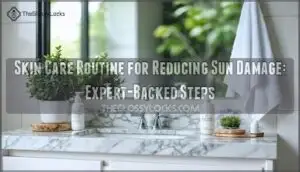
These powerhouse ingredients help fade dark spots and boost collagen production. Don’t skip moisturizer – it keeps your skin barrier strong while treatments do their work.
Sunscreen is non-negotiable, even on cloudy days, because prevention beats correction every time. Chemical exfoliants like glycolic acid can speed up cell turnover, revealing fresher skin underneath.
The key is consistency and patience – your skin didn’t develop damage overnight, so healing takes time too. Professional treatments and prescription options can accelerate your results substantially, using powerhouse ingredients to enhance the process, and ultimately leading to a stronger skin barrier through gentle cleansing.
Table Of Contents
- Key Takeaways
- Preventing Sun Damage
- Identifying Signs of Sun Damage
- Reversing Sun Damage
- Treating Sun-Damaged Skin
- Maintaining Healthy Skin
- Consulting a Dermatologist
- Frequently Asked Questions (FAQs)
- What skincare routine is good for sun damage?
- What helps heal sun-damaged skin?
- What skin treatment removes sun damage?
- How to save your skin from sun damage?
- What is the best skin care for sun-damaged skin?
- What skincare reverses sun damage?
- How to repair skin from sun damage?
- How can I save my skin from sun damage?
- Can sun damage be reversed with over-the-counter products only?
- How long does it take to see results from treatments?
- Conclusion
Key Takeaways
- Start with consistent daily sunscreen (SPF 30+) – this prevents more damage while you’re repairing existing issues
- Use vitamin C serum in the morning and retinoids at night to fade dark spots and boost collagen production
- Add gentle chemical exfoliants like glycolic acid to speed up cell turnover and reveal fresher skin underneath
- Be patient with your routine – you’ll need 3-6 months of consistent use to see significant results from sun damage repair
Preventing Sun Damage
You can’t undo years of sun damage overnight, but starting a prevention routine today stops additional harm from accumulating.
The best defense against UV rays combines daily broad-spectrum sunscreen with protective clothing and smart timing when you’re outdoors.
Understanding The Effects of UV Rays
When you’re exposed to UV rays, your skin cells suffer DNA damage that triggers the photoaging process.
UV damage happens at the cellular level, silently aging your skin from within.
UVA penetration occurs year-round through clouds and glass, while UVB effects cause visible burns.
This sun damage accumulates over time, leading to premature aging and serious skin concerns.
Even tanning dangers aren’t obvious—that golden glow actually signals cellular harm beneath the surface.
Building a Daily Sun Protection Habit
Making sun protection your daily default starts with sunscreen application every morning—think of it as your skin’s insurance policy.
Choose broad spectrum sunscreen with SPF 30+, reapply every two hours, and pair it with protective clothing choices like wide-brimmed hats.
Seek shade during peak hours and remember: year-round protection matters since UV rays penetrate clouds and windows.
Choosing The Right Sunscreen for Your Skin Type
Your skin type determines which sunscreen works best for you.
Fair-skinned individuals need SPF 50+ for maximum protection, while darker skin tones can use SPF 30+ but still require broad spectrum coverage against UVA damage.
Choose mineral sunscreens for sensitive skin or chemical sunscreens for oily skin types. Many people use mineral sunscreens effectively on sensitive skin.
Protecting Your Skin From Artificial Tanning
Break free from tanning beds – they’re fast-tracking skin cancer risks and sun damage prevention nightmares.
Artificial UV rays deliver concentrated damage, with noticeable aging within a year.
Indoor tanning bans exist for good reason.
Choose safe alternatives like spray tan safety-approved products instead.
Your skin deserves protection from these UV exposure limits-busting machines.
Identifying Signs of Sun Damage
You can identify sun damage by looking for visible signs that develop over time from UV exposure.
Common indicators include wrinkles, age spots, loose skin, uneven pigmentation, and potentially dangerous growths like actinic keratoses that require medical attention.
Recognizing Wrinkles, Age Spots, and Loose Skin
Looking in the mirror, you might spot fine lines around your eyes, dark spots on your cheeks, or sagging skin that wasn’t there before.
These changes signal sun damage, not just natural aging. Wrinkle formation accelerates with UV exposure, while spot identification reveals melanin clusters from years of sun.
Loss of elasticity creates that loose, tired appearance. Early detection through regular self-examination helps you address damage before it worsens.
Understanding Actinic Keratoses (AKs) and Skin Cancer
Beyond wrinkles and age spots, actinic keratoses (AKs) represent sun damage’s most serious threat.
These rough, scaly patches are precancerous growths affecting over 58 million Americans yearly.
**Warning signs aren’t subtle—these scaly patches demand immediate attention before they turn deadly.
Without early detection and treatment options like topical medications or laser therapy, 10-20% of AKs progress to squamous cell carcinoma within a decade, making preventative measures absolutely essential.
How Sun Damage Affects Hyperpigmentation
UV damage triggers melanin overproduction, creating stubborn dark spots and uneven skin tone.
This hyperpigmentation affects all skin types differently:
- Sunspots: Brown patches from cumulative UV exposure
- Melasma: Hormone-triggered patches worsened by sun
- Post-inflammatory hyperpigmentation: Dark marks after breakouts or injuries
- Freckles: Small concentrated melanin deposits
- Age spots: Large pigmented areas from years of sun damage
To prevent further darkening, daily sunscreen use is essential.
Reversing Sun Damage
If you’ve noticed signs of sun damage on your skin, you’re not alone—but the good news is that many of these changes can be improved with the right approach.
From topical treatments that work at the cellular level to professional procedures that resurface damaged skin, there are proven methods to help restore your skin’s health and appearance, using techniques that can improve skin health through topical treatments.
Using Topical Treatments Like Retinoids and Vitamin C
Once you’ve spotted sun damage signs, it’s time for targeted repair.
Topical treatments offer powerful results when used correctly:
- Retinoid Benefits: These vitamin A derivatives accelerate cell turnover and boost collagen production, smoothing wrinkles and evening skin tone.
- Vitamin C Serums: This potent antioxidant brightens hyperpigmentation while protecting against future oxidative damage from UV exposure.
- Combining Actives: Layer vitamin C serum in the morning under sunscreen, then apply retinol treatment at night for ideal sun damage repair without irritation.
Retinoids can help reverse effects of sun damage.
Exfoliating With Chemical Peels and Microdermabrasion
Chemical peels and microdermabrasion tackle stubborn sun damage by removing damaged surface layers.
Chemical peel types range from gentle glycolic to stronger trichloroacetic acids, while peel strength determines downtime.
Microdermabrasion frequency typically starts weekly, progressing based on tolerance.
Post-peel care requires gentle cleansing and diligent sun protection.
Treatment combinations amplify results, but proper skin exfoliation timing prevents irritation during your sun damage repair journey.
Many factors influence selecting proper peels.
Laser Resurfacing and Intense-Pulsed Light Therapy
Laser resurfacing removes damaged skin layers while IPL targets pigmentation using broad-spectrum light.
Laser treatment offers dramatic results but requires more downtime – typically 1-7 days versus IPL’s minimal recovery.
Treatment comparison shows lasers excel at deeper sun damage treatment, while IPL benefits include gentler hyperpigmentation correction.
Cost considerations vary substantially between modalities.
Filling in Wrinkles With Injectables and Fillers
While laser and IPL target deeper damage, fillers offer immediate wrinkle correction for sun-damaged skin.
Here’s what you need to know about injection techniques and filler types:
- Hyaluronic acid fillers plump fine lines instantly, lasting 6-18 months
- Collagen-stimulating options like Sculptra rebuild skin thickness over time
- Wrinkle severity determines which filler types work best for your concerns
- Expected results include 80% wrinkle reduction in treated areas
- Procedure risks involve temporary bruising, with rare complications under 1%
These fillers can also restore lost volume.
Treating Sun-Damaged Skin
Once you’ve identified sun damage on your skin, the next step is choosing effective treatments that match your specific concerns and skin type.
Whether you’re dealing with dark spots, fine lines, or uneven texture, the right combination of ingredients and professional procedures can help restore your skin’s health and appearance.
Choosing The Right Treatments for Your Skin Concerns
When choosing treatments across different price points, you’ll want to match your specific skin concerns with targeted solutions.
Treatment Personalization guarantees you’re addressing your unique sun damage patterns, whether that’s hyperpigmentation or fine lines.
| Concern | At-Home Option | Professional Treatment |
|---|---|---|
| Dark spots | Vitamin C + niacinamide | Chemical peels |
| Fine lines | Retinol serums | Laser resurfacing |
| Uneven texture | AHA exfoliants | Microneedling |
For ideal results, consider how antioxidants neutralize free radicals, supporting skin repair.
Consider Combination Therapies and Cost Considerations when planning your sun damage repair strategy.
Understanding The Role of Prescription Retinoids
Prescription retinoids pack serious punch against sun damage repair, delivering faster results than over-the-counter options.
While these powerhouse ingredients accelerate skin aging reversal, they require careful irritation management and gradual introduction into your skin care routine.
Here are five key considerations for prescription retinoids:
- Prescription Strength delivers faster collagen production and cell turnover than drugstore alternatives
- Retinoid Benefits include reducing fine lines, age spots, and overall skin damage repair
- Irritation Management requires starting slowly—twice weekly initially—with proper moisturizing
- Long-Term Use shows continued improvement over months, making patience essential for results
- Alternative Options like tretinoin or adapalene offer different strengths for various skin sensitivities
How to Use Moisturizers and Serums for Sun-Damaged Skin
Consistently applying the right moisturizers and serums can dramatically improve your sun-damaged skin’s appearance.
You’ll want to focus on Repairing Barrier function while boosting Hydration Levels for ideal skin repair. Smart Layering Techniques and understanding Ingredient Synergy make all the difference in Serum Penetration.
Here’s your game plan:
- Start with an antioxidant serum containing vitamin C to combat sun damage and brighten your complexion
- Follow with a hydrating moisturizer featuring hyaluronic acid to plump fine lines and restore moisture
- Apply products in thin layers, allowing complete absorption between each step for maximum skin barrier repair benefits
Considering Professional Treatments Like Laser and Ultrasound
While serums and moisturizers work wonders, professional treatments deliver faster, more dramatic results.
Laser resurfacing and ultrasound therapy target deeper damage that topicals can’t reach.
Microneedling RF stimulates collagen production, while combination therapies maximize effectiveness.
Your dermatologist can recommend the best in-office treatments for your specific sun damage concerns.
Maintaining Healthy Skin
Once you’ve addressed existing sun damage, maintaining healthy skin becomes your top priority for preventing future harm.
A consistent daily routine combined with ongoing protection keeps your skin resilient and helps preserve the improvements you’ve worked hard to achieve, with healthy skin and ongoing protection being crucial.
Creating a Consistent Skincare Routine
Your skin care routine becomes your daily armor against further sun damage when you stick to it religiously.
Routine adherence means applying products in the right order—cleanser, treatment serums, moisturizer, then SPF protection each morning.
Skin cycling helps prevent irritation by rotating active ingredients throughout the week.
Your personalized routine should include seasonal adjustments since winter requires heavier moisturizers while summer needs lightweight formulas.
Product layering maximizes benefits when done consistently.
Staying Hydrated and Eating an Antioxidant-Rich Diet
When hydration meets nutrition, your skin wins the battle against sun damage.
Drinking eight glasses of water daily supports Hydration Benefits and Cellular Repair, while Antioxidant Sources like blueberries and spinach provide vitamin C for Skin Health.
These foods boost skin hydration and combat free radicals, showing significant Diet Impact on antioxidants levels and overall skin health.
Regular exfoliation helps to remove dead skin cells for improved texture.
Getting Enough Sleep and Managing Stress
Quality Sleep Quality directly impacts your skin’s Cellular Repair process and Skin Health.
During those precious 7-8 hours, your body works overtime repairing skin damage while you rest.
High Stress Hormones from poor sleep can sabotage your skin care routine efforts.
Managing stress through meditation supports both Mental Wellbeing and skin rejuvenation, creating the perfect environment for skin repair.
Protecting Your Skin From Further Sun Damage
Three key habits shield your skin from further UV damage daily.
First, apply broad-spectrum SPF 30 sunscreen every morning and reapply every two hours, especially during peak hours (10 AM-4 PM).
Second, seek shade and wear protective clothing like wide-brimmed hats when the UV index is high.
These simple sun protection strategies prevent additional sun damage effectively.
Consulting a Dermatologist
When you’re dealing with stubborn sun damage that won’t respond to over-the-counter treatments, it’s time to consult a dermatologist who can assess your specific skin concerns and recommend targeted solutions.
A professional evaluation helps you understand which prescription treatments, in-office procedures, or combination therapies will work best for your skin type and damage level, providing a clear path to addressing your unique skin concerns with targeted solutions.
What to Expect From a Dermatology Consultation
Your dermatology consultation begins with an Initial Assessment where you’ll discuss your skin concerns, medical history, and current skin care routine.
The dermatologist performs a thorough Skin Analysis to identify sun damage signs and evaluate treatment needs. You’ll receive personalized Treatment Options suited to your specific skin damage patterns.
- Consultation Cost varies by location and insurance coverage, but most initial visits range from $150-400
Expect discussion of Follow-up Care scheduling and sun protection strategies to prevent further damage.
How a Dermatologist Can Evaluate Your Skin Condition
Your dermatologist performs a thorough Skin Analysis during your Dermatologist Consult, examining multiple factors that influence sun damage.
They’ll assess your skin type, tone, and current condition while reviewing your medical history and lifestyle habits.
This thorough Condition Assessment includes skin mapping to identify problem areas and UV damage patterns.
Skin Type Skin History Lifestyle Habits
Your dermatologist uses specialized tools for Medical Diagnosis, evaluating sun damage severity and recommending personalized UV damage recovery strategies for ideal skin protection.
Choosing The Right Treatments With a Dermatologist’s Guidance
Your dermatologist becomes your partner in crafting personalized treatment plans that match your unique skin analysis and goals.
They’ll evaluate your sun damage severity, skin type, and medical history to recommend the safest, most effective approach.
Here’s what dermatologist advice typically covers:
- Sunscreen Options – Custom recommendations based on your skin’s specific needs and sensitivities
- Treatment Plans – Combining prescription retinoids with over-the-counter antioxidants for ideal results
- Cosmetic Procedures – Selecting laser resurfacing, chemical peels, or microneedling based on damage severity
- UV Damage Recovery – Monitoring progress and adjusting your skin care routine as healing occurs
Preventing Skin Cancer With Regular Check-Ups
Beyond choosing treatments with your dermatologist, regular Cancer Screening becomes your safety net against skin cancer.
Early Detection through routine Dermatologist Visits can literally save your life—catching changes before they become serious problems.
Here’s your prevention playbook:
- Schedule annual skin checks if you’re high-risk or have suspicious moles
- Perform monthly self-exams using mirrors to spot new growths or changes
- Maintain daily Sun Protection with broad-spectrum SPF, even indoors near windows
- Document skin changes with photos to track evolution between visits
Frequently Asked Questions (FAQs)
What skincare routine is good for sun damage?
Better late than never when tackling sun damage! You’ll need gentle cleanser, vitamin C serum, retinol, niacinamide, moisturizer, and broad-spectrum SPF 30+ sunscreen daily, reapplying every two hours.
What helps heal sun-damaged skin?
Retinoids boost cell turnover while vitamin C fights free radicals and stimulates collagen.
Niacinamide reduces dark spots, and gentle exfoliating acids brighten skin.
Professional chemical peels accelerate healing for deeper damage.
What skin treatment removes sun damage?
Your skin’s battle scars from UV exposure can fade with professional treatments. Chemical peels, laser resurfacing, and microneedling effectively remove damaged layers, revealing fresher skin underneath.
How to save your skin from sun damage?
Use broad-spectrum SPF 30+ sunscreen daily, seek shade between 10 a.m.
-4 p.m., wear protective clothing and sunglasses, and avoid tanning beds completely.
What is the best skin care for sun-damaged skin?
Daily broad-spectrum SPF 30+ sunscreen is essential. Add vitamin C serum for antioxidant protection, retinoids for cell turnover, and niacinamide for dark spots. You’ll see gradual improvement.
What skincare reverses sun damage?
Ironically, you’re trying to undo yesterday’s sun worship with today’s skincare obsession.
Retinoids boost cell turnover while vitamin C fights hyperpigmentation.
Add niacinamide for barrier support, but consistency trumps perfection here.
How to repair skin from sun damage?
Apply sunscreen daily with SPF 30+, use retinoids for cell turnover, vitamin C for collagen repair, and gentle exfoliation. Professional treatments like chemical peels accelerate healing.
How can I save my skin from sun damage?
Think of sun protection like armor for your skin—you’ll need daily broad-spectrum SPF 30+ sunscreen, protective clothing, and shade between 10 a.m. and 2 p.m. to shield against damaging UV rays.
Can sun damage be reversed with over-the-counter products only?
Yes, you can reverse some sun damage with over-the-counter products. Vitamin C serums, retinol, niacinamide, and AHAs effectively fade dark spots, improve texture, and boost collagen production over time.
How long does it take to see results from treatments?
Like watching a garden bloom, skin transformation unfolds gradually.
You’ll notice initial improvements in 4-6 weeks with OTC products, while prescription treatments show significant results in 3-6 months with consistent use, leading to significant results.
Conclusion
Studies show that 90% of visible aging comes from sun exposure, making your efforts worthwhile.
Building an effective skin care routine for reducing sun damage requires dedication, but you’ll see gradual improvements with consistent use of retinoids, vitamin C, and sunscreen.
Remember that reversing years of damage takes time – typically 3-6 months for noticeable changes, so stay patient with your routine, protect your skin daily, and consider professional treatments for faster results when needed.
- https://healthy.kaiserpermanente.org/health-wellness/healtharticle.surprising-ways-you-may-be-getting-sun-damaged-skin
- https://www.aad.org/news/new-aad-survey-reveals-growing-importance-sun-protection
- https://newsinhealth.nih.gov/2014/07/sun-skin
- https://www.academicallderm.com/blog/how-to-fix-sun-damaged-skin/
- https://karammdskin.com/blogs/expert-advice/natures-toolbox-demystifying-natural-ingredients-that-soothe-sun-damaged-skin

